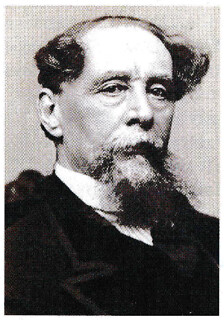
In the December 2013 issue of The Numismatist (the monthly publication of the American Numismatic Association), John Kleeberg published an article on Charles Dickens'
Numismatic References in A Christmas Carol. Here's an excerpt. -Editor
 Charles Dickens' novella A Christmas Carol, first published in December 1843, enjoys undiminished popularity. Although Dickens reveled in the details of Christmas shopping, he
skimped on the details of monetary tiansactions. The reader is told about the scales, the twine and roller, the smell of tea and coffee, and the wicker shopping baskets, but never how much the items
cost. Charles Dickens' novella A Christmas Carol, first published in December 1843, enjoys undiminished popularity. Although Dickens reveled in the details of Christmas shopping, he
skimped on the details of monetary tiansactions. The reader is told about the scales, the twine and roller, the smell of tea and coffee, and the wicker shopping baskets, but never how much the items
cost.
This omission was deliberate. Dickens disapproved of monetary transactions, relegating them to the world of the "old" Scrooge, that is, before the stingy character was transformed. The
very items used to process monetary transactions, such as cash boxes, keys, padlocks, ledgers, deeds and healy purses, become the chain that weighs down Marley's ghost.
Money as a Metaphor
Coins in A Christmas Carol often serve as metaphors for something of little monetary value, like the American expressions "red cent" or "thin dime." Dickens refers to the
farthing, penny, twopence and sixpence in this way. After Scrooge's transformation, he pledges to provide food and fuel for the poor and declares he will donate "not a farthing less."
When Joe says that his offer is final, he explains, "If you asked me for another penny, and made it an open question, I'd repent of being so liberal and knock off half-a-crown." When
the Cratchits drink to Scrooge's health, Tiny Tim "didn't care twopence for it."
In A Christmas Carol, the sixpence appears twice. Joe, again presenting a final offer, says "I wouldn't give another sixpence, if I was to be boiled for not doing it." And
Mrs. Cratchit appears "brave in ribbons, which are cheap and make a goodly show for sixpence."
A Generous Tip
When Scrooge sends a boy off to buy a gigantic turkey, he offers a generous tip: "Come back with the man, and I'll give you a shilling. Come back with him in less than five minutes, and
I'll give you half-a-crown!" A half crown (2 shillings, 6 pence), the largest silver coin in general circulation, was a magnanimous gratuity in the Victorian period.
Coins in the 1951 Movie Version
 The best film treatment of A Christmas Carol is generally agreed to be the 1951 version starring Alastair Sim. The film adds two notable numismatic references to those of the novel.
The halfpenny appears as another denomination when Scrooge asks the waiter for "More bread!" The waiter responds that it would be a "halfpenny extra," whereupon the miserly
Scrooge decides to go without. The other numismatic instance transpires when Scrooge gives a coin to his char-woman, Mrs. Dilber, as a Christmas present, and she looks down in astonishment to see
'A guinea!" The best film treatment of A Christmas Carol is generally agreed to be the 1951 version starring Alastair Sim. The film adds two notable numismatic references to those of the novel.
The halfpenny appears as another denomination when Scrooge asks the waiter for "More bread!" The waiter responds that it would be a "halfpenny extra," whereupon the miserly
Scrooge decides to go without. The other numismatic instance transpires when Scrooge gives a coin to his char-woman, Mrs. Dilber, as a Christmas present, and she looks down in astonishment to see
'A guinea!"
ANA members can read the complete article at:
/www.money.org/thenumismatist/digitalarchives
Wayne Homren, Editor
The Numismatic Bibliomania Society is a non-profit organization
promoting numismatic literature. See our web site at coinbooks.org.
To submit items for publication in The E-Sylum, write to the Editor
at this address: whomren@gmail.com
To subscribe go to: https://my.binhost.com/lists/listinfo/esylum
Copyright © 1998 - 2020 The Numismatic Bibliomania Society (NBS)
All Rights Reserved.
NBS Home Page
Contact the NBS webmaster
|



